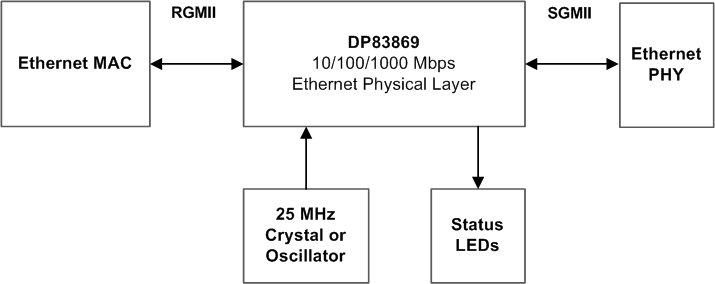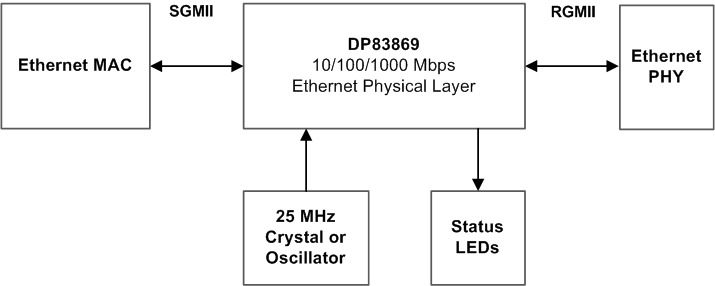SNLS614D September 2018 – June 2025 DP83869HM
PRODUCTION DATA
- 1
- 1 Features
- 2 Applications
- 3 Description
- 4 Device Comparison
- 5 Pin Configuration and Functions
- 6 Specifications
-
7 Detailed Description
- 7.1 Overview
- 7.2 Functional Block Diagram
- 7.3
Feature Description
- 7.3.1 WoL (Wake-on-LAN) Packet Detection
- 7.3.2 Start of Frame Detect for IEEE 1588 Time Stamp
- 7.3.3 Clock Output
- 7.3.4 Loopback Mode
- 7.3.5 BIST Configuration
- 7.3.6 Interrupt
- 7.3.7 Power-Saving Modes
- 7.3.8 Mirror Mode
- 7.3.9 Speed Optimization
- 7.3.10 Cable Diagnostics
- 7.3.11 Fast Link Drop
- 7.3.12 Jumbo Frames
- 7.4
Device Functional Modes
- 7.4.1 Copper Ethernet
- 7.4.2 Fiber Ethernet
- 7.4.3 Serial GMII (SGMII)
- 7.4.4 Reduced GMII (RGMII)
- 7.4.5 Media Independent Interface (MII)
- 7.4.6 Bridge Modes
- 7.4.7 Media Convertor Mode
- 7.4.8 Register Configuration for Operational Modes
- 7.4.9 Serial Management Interface
- 7.4.10
Auto-Negotiation
- 7.4.10.1 Speed and Duplex Selection - Priority Resolution
- 7.4.10.2 Leader and Follower Resolution
- 7.4.10.3 Pause and Asymmetrical Pause Resolution
- 7.4.10.4 Next Page Support
- 7.4.10.5 Parallel Detection
- 7.4.10.6 Restart Auto-Negotiation
- 7.4.10.7 Enabling Auto-Negotiation Through Software
- 7.4.10.8 Auto-Negotiation Complete Time
- 7.4.10.9 Auto-MDIX Resolution
- 7.5
Programming
- 7.5.1
Strap Configuration
- 7.5.1.1 Straps for PHY Address
- 7.5.1.2 Strap for DP83869HM Functional Mode Selection
- 7.5.1.3 LED Default Configuration Based on Device Mode
- 7.5.1.4 Straps for RGMII/SGMII to Copper
- 7.5.1.5 Straps for RGMII to 1000Base-X
- 7.5.1.6 Straps for RGMII to 100Base-FX
- 7.5.1.7 Straps for Bridge Mode (SGMII-RGMII)
- 7.5.1.8 Straps for 100M Media Convertor
- 7.5.1.9 Straps for 1000M Media Convertor
- 7.5.2 LED Configuration
- 7.5.3 Reset Operation
- 7.5.1
Strap Configuration
- 7.6 Register Maps
-
8 Application and Implementation
- 8.1 Application Information
- 8.2 Typical Applications
- 8.3 Power Supply Recommendations
- 8.4 Layout
- 9 Device and Documentation Support
- 10Revision History
- 11Mechanical, Packaging, and Orderable Information
Package Options
Mechanical Data (Package|Pins)
- RGZ|48
Thermal pad, mechanical data (Package|Pins)
Orderable Information
3 Description
The DP83869HM device is a robust, fully-featured gigabit physical layer (PHY) transceiver with integrated PMD sublayers that supports 10BASE-Te, 100BASE-TX and 1000BASE-T Ethernet protocols. The DP83869 also supports 1000BASE-X and 100BASE-FX fiber protocols. Optimized for ESD protection, the DP83869HM exceeds 8kV IEC 61000-4-2 (direct contact).This device interfaces to the MAC layer through reduced GMII (RGMII) and SGMII. In 100M mode, the device lets the designer use MII for lower latency. Programmable integrated termination impedance on RGMII/MII helps reduce system BOM.
The DP83869HM supports media conversion in unmanaged mode. In this mode, the DP83869HM can run 1000BASE-X-to-1000BASE-T and 100BASE-FX-to-100BASE-TX conversions.
The DP83869HM can also support bridge conversion from RGMII to SGMII and SGMII to RGMII. The DP83869HM is compliant to TSN standards and offers low latency.
The DP83869HM can also generate IEEE 1588 Sync Frame Detect indications to MAC. This can reduce the jitter in Time Synchronization and help the System account for asymmetric delays in Transmission and Reception of packets.
The standard Ethernet system block diagram is shown on the first page. Designers can also use the DP83869 in Media Convertor mode, in RGMII-to-SGMII Bridge applications, and in SGMII-RGMII Bridge applications.
| PART NUMBER | PACKAGE (1) | PACKAGE SIZE(2) |
|---|---|---|
| DP83869HM | RGZ (VQFN, 48) | 7mm × 7mm |
| DP83867E/IS/CS | RGZ (VQFN, 48) | 7mm × 7mm |
| DP83867IR/CR | RGZ (VQFN, 48) | 7mm × 7mm |
 Standard Ethernet System Block Diagram
Standard Ethernet System Block Diagram Figure 3-1 Media Convertor System Block
Diagram
Figure 3-1 Media Convertor System Block
Diagram Figure 3-2 RGMII-SGMII Bridge System Block
Diagram
Figure 3-2 RGMII-SGMII Bridge System Block
Diagram Figure 3-3 SGMII-RGMII Bridge System Block
Diagram
Figure 3-3 SGMII-RGMII Bridge System Block
Diagram